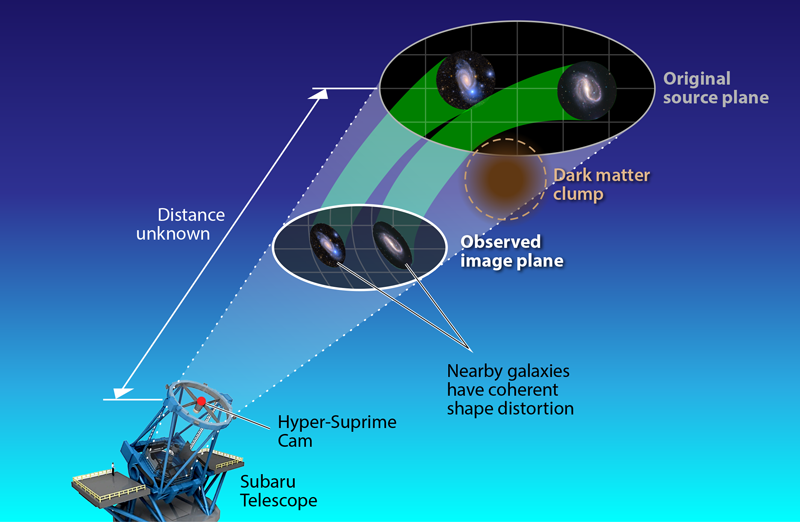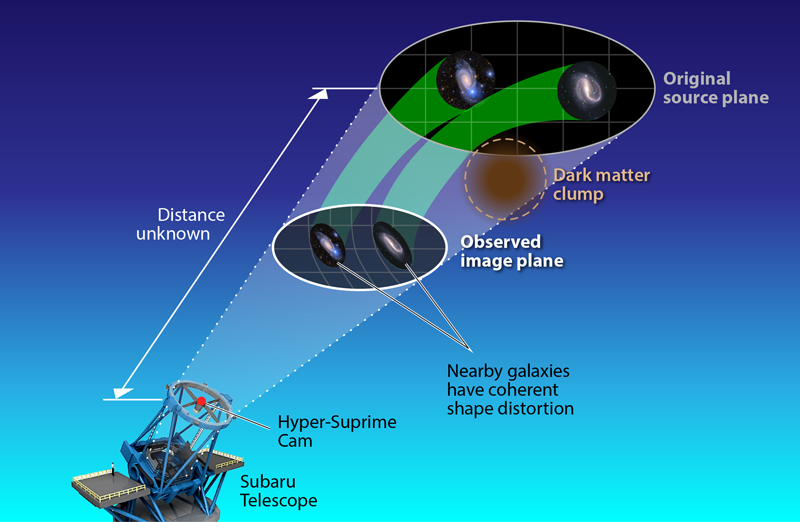Inconsistency Turns Up Again for Cosmological Observations
Cosmologists study the Universe by making a vast range of observations using a variety of modern techniques. Each observation can reveal different details about the Universe’s composition over a certain period of its history. An astronomical survey—a map of a region of the sky—is a powerful way to scan a large swath of the Universe and the objects it contains. For example, a weak-lensing survey does that by obtaining sharp images of galaxies, which can then be used to map the distribution of the Universe’s matter throughout history. The Hyper Suprime-Cam Subaru Strategic Program (HSC-SSP) is one such weak-lensing survey, and it has the highest resolution and the deepest depth of all current weak-lensing surveys. Over the past six years, the HSC-SSP survey team has spent 330 nights scanning 3% of the entire spherical sky, capturing the light emitted by galaxies up to 10 billion years ago. The team has now analyzed 40% of its data [1–5], finding results that are inconsistent with the predictions of cosmological models derived from Planck-satellite data of the early Universe, such as measurements of the Universe’s first light. This inconsistency has repeatedly turned up in weak-lensing surveys, suggesting there exists a fundamental defect in the standard cosmological model, known as ΛCDM.
Traditionally, astronomers use light directly emitted from an astrophysical object to investigate the properties of that object. Gravitational-lensing surveys instead use the light emitted from behind an object to infer the object’s presence. When light is emitted by a distant object, it can get diverted from its path by the gravitational pull of matter between the object and the observer. This bending can distort the shape of a distant galaxy—an effect termed weak gravitational lensing (Fig. 1). This shape distortion is coherent for nearby galaxies because the light from them travels through the same region of space as it makes its way to the observer. Gravitational-lensing surveys can thus detect objects that themselves emit no light, such as clumps of dark matter, and weak lensing primarily detects dark matter along the line of sight to a galaxy. Although the effect is small for most galaxies, when measurements are made of millions of galaxies, the overall characteristics of the weak-lensing signal can determine cosmological parameters with high precision (see Viewpoint: Weak Lensing Becomes a High-Precision Survey Science).
Among the ongoing weak-lensing surveys, the HSC-SSP survey probes the farthest into the Universe, meaning that it can capture information about more of the Universe’s past. However, the farther away a galaxy is, the trickier it is to accurately determine its shape and distance—two pieces of information needed to determine the amount of weak lensing. Accurate distance measurements can be obtained using spectroscopic observations. However, current publicly available spectroscopic-observation data lack information on the most distant of the galaxies in the HSC-SSP survey. The HSC-SSP team mitigates this distance problem via a “self-calibration” technique. But the calibration process adds an extra degree of freedom to the modeling that ultimately reduces the precision of the cosmological measurements.
Using their galaxy shape and distance measurements, the HSC-SSP collaboration provides an estimate of the matter distribution in the Universe. As in previous surveys, the researchers analyze this distribution to determine how much the matter density fluctuates across space. One way to characterize these matter fluctuations is with a parameter called S8, which is a measure of the clumpiness of matter—both visible and dark—in the Universe. The HSC-SSP collaboration reports four values of cosmological parameter S8, each calculated via a different analysis protocol. The values range from 0.763 to 0.776 ( ±0.033). These values of S8 are consistent with the values obtained by other weak-lensing surveys [6, 7] but are lower than the 0.832±0.013 measured by the Planck Collaboration, which makes observations of the early Universe. When put into ΛCDM, an S8 of 0.776 leads to the prediction that today’s Universe is much less clumpy than it would be for an S8 of 0.832 , indicating a possible failure of ΛCDM. If further measurements support that conclusion, cosmologists will need to build new cosmological models that can explain both the early- (Planck) and later- (HSC-SSP) Universe data.
To make those further measurements, cosmologists need upgraded observational capabilities. Some of those capabilities are coming, for example, through the recently launched Euclid telescope from the European Space Agency and the soon-to-be-turned-on Vera C. Rubin Observatory in Chile. Also in development are the Nancy Grace Roman Space Telescope and the Chinese Survey Space Telescope. Each of those facilities will offer the possibility of observing billions rather than millions of galaxies and around 10 times more of the sky than the HSC-SSP observed. The future space telescopes will also have resolutions about 7 times better than that of the HSC. By observing billions of galaxies with such unprecedented sky coverage and resolution, these upcoming surveys will significantly expand our view of the Universe. The timely release of the new HSC-SSP results and the knowledge the collaboration has developed in building robust analysis pipelines will be valuable for the success of these upcoming surveys. An exciting era for cosmology is about to start.
References
- R. Dalal et al., “Hyper Suprime-Cam Year 3 results: Cosmology from cosmic shear power spectra,” Phys. Rev. D 108, 123519 (2023).
- X. Li et al., “Hyper Suprime-Cam Year 3 results: Cosmology from cosmic shear two-point correlation functions,” Phys. Rev. D 108, 123518 (2023).
- S. More et al., “Hyper Suprime-Cam Year 3 results: Measurements of clustering of SDSS-BOSS galaxies, galaxy-galaxy lensing, and cosmic shear,” Phy. Rev. D 108, 123520 (2023).
- S. Sugiyama et al., “Hyper Suprime-Cam Year 3 results: Cosmology from galaxy clustering and weak lensing with HSC and SDSS using the minimal bias model,” Phys. Rev. D 108, 123521 (2023).
- H. Miyatake et al., “Hyper Suprime-Cam Year 3 results: Cosmology from galaxy clustering and weak lensing with HSC and SDSS using the emulator based halo model,” Phys. Rev. D 108, 123517 (2023).
- C. Heymans et al., “KiDS-1000 Cosmology: Multi-probe weak gravitational lensing and spectroscopic galaxy clustering constraints,” Astron. Astrophys. 646, A140 (2021).
- T. M. C. Abbott et al. (DES Collaboration), “Dark Energy Survey Year 3 results: Cosmological constraints from galaxy clustering and weak lensing,” Phys. Rev. D 105, 023520 (2022).





